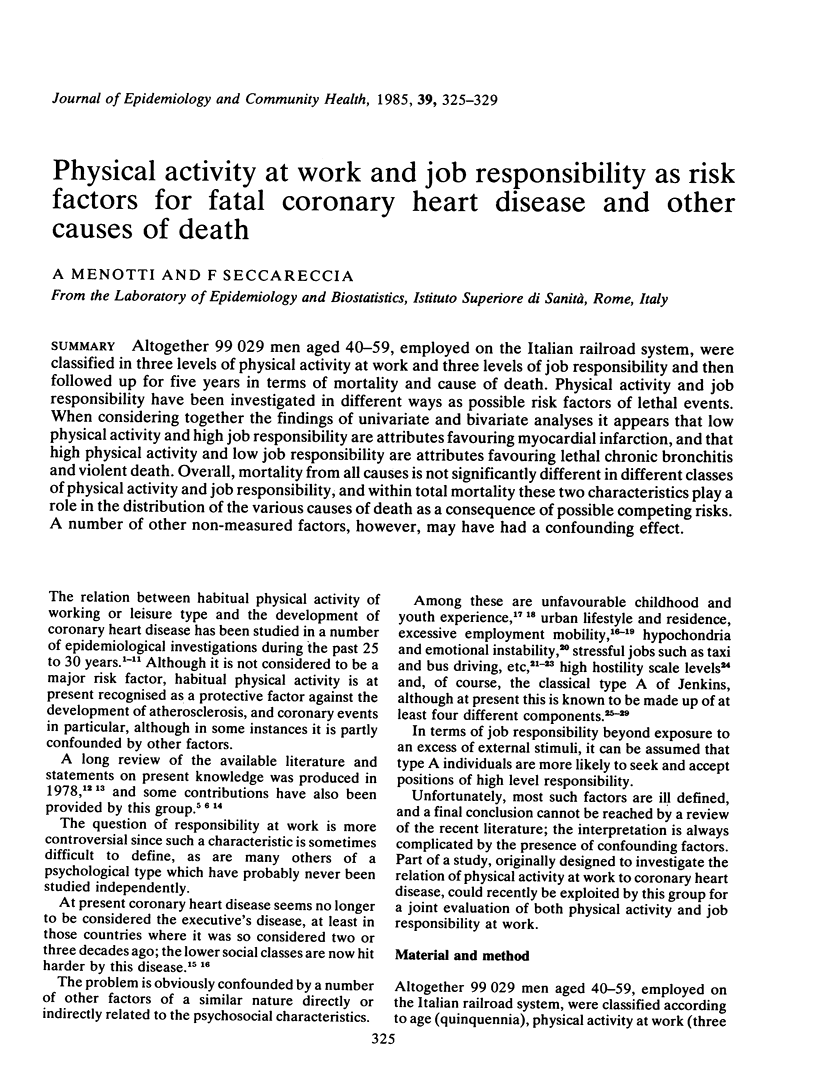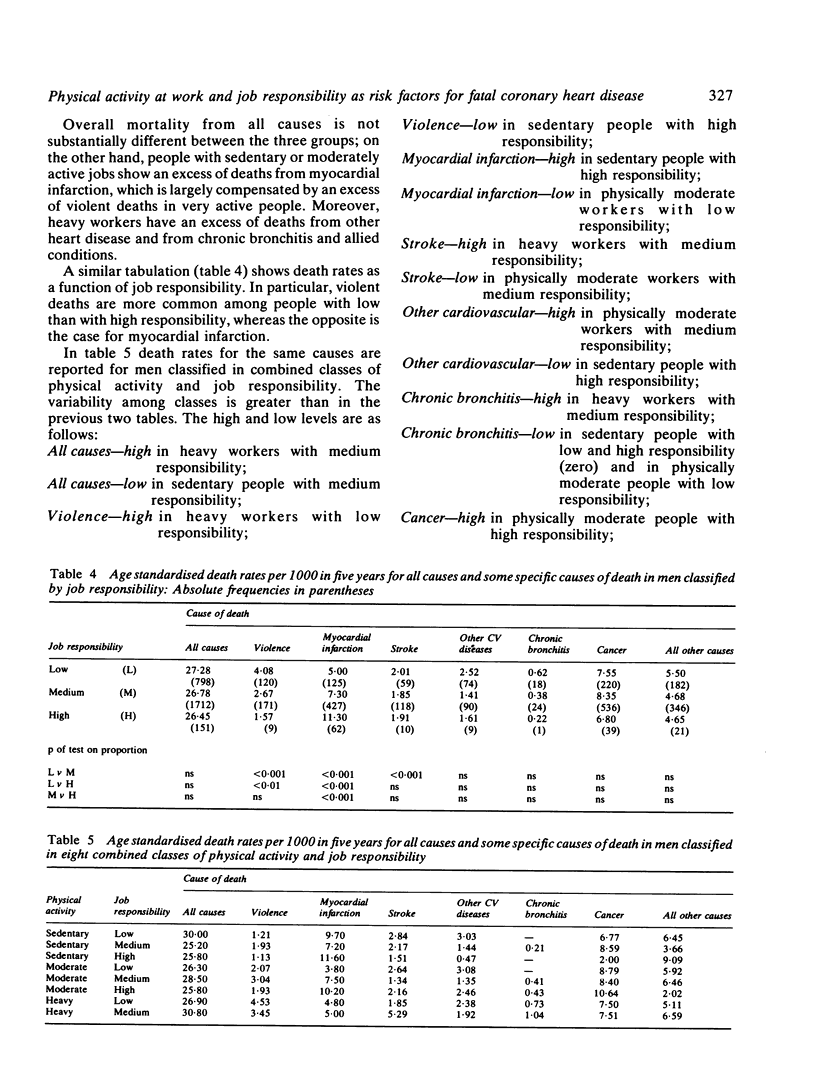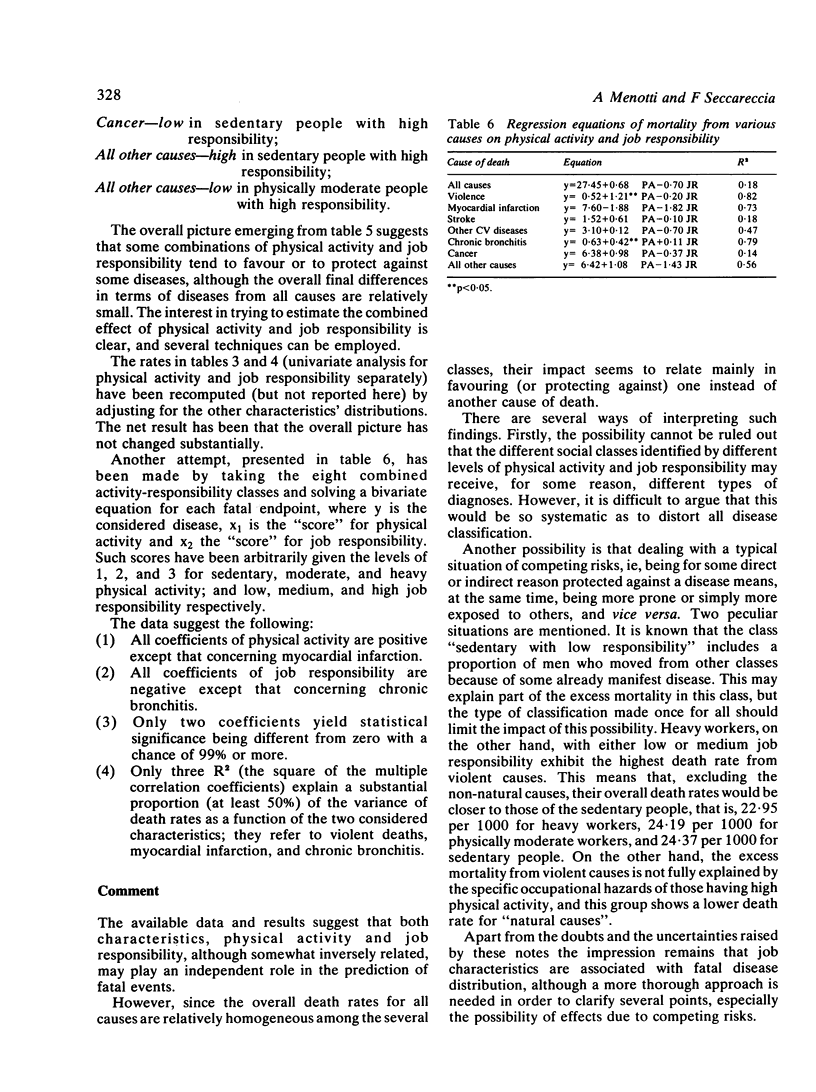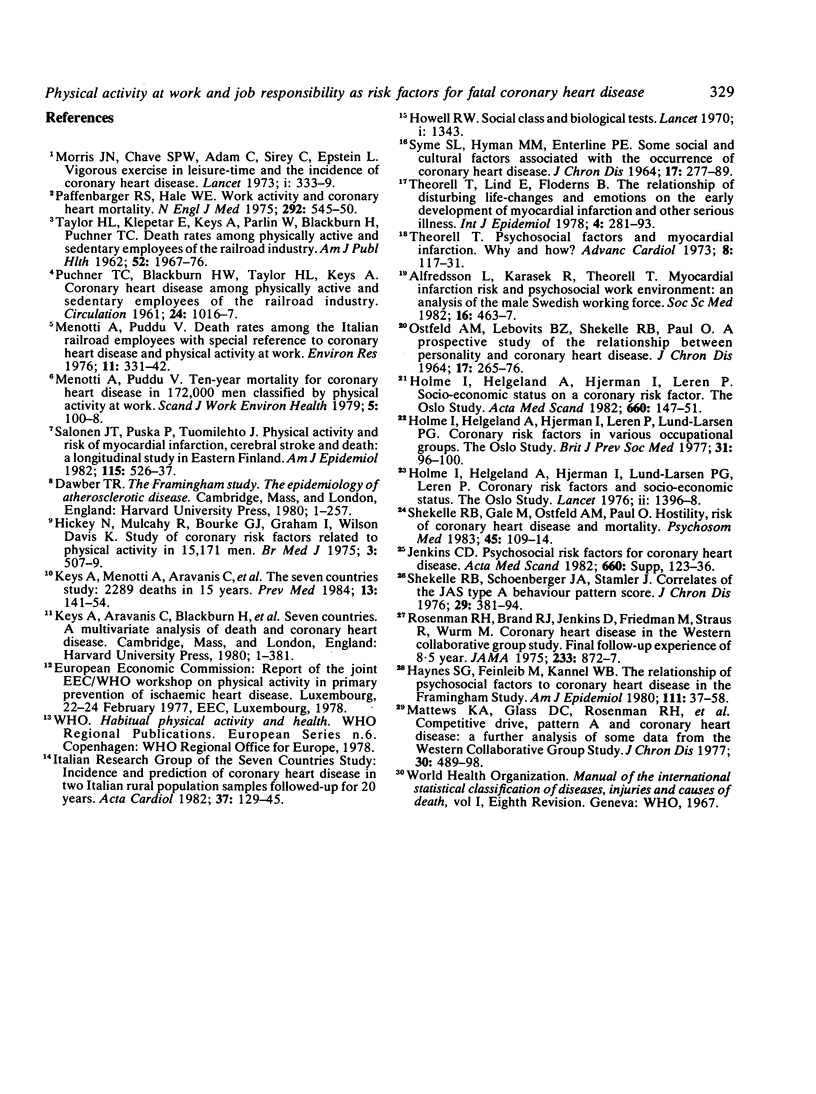Abstract
Altogether 99 029 men aged 40-59, employed on the Italian railroad system, were classified in three levels of physical activity at work and three levels of job responsibility and then followed up for five years in terms of mortality and cause of death. Physical activity and job responsibility have been investigated in different ways as possible risk factors of lethal events. When considering together the findings of univariate and bivariate analyses it appears that low physical activity and high job responsibility are attributes favouring myocardial infarction, and that high physical activity and low job responsibility are attributes favouring lethal chronic bronchitis and violent death. Overall, mortality from all causes is not significantly different in different classes of physical activity and job responsibility, and within total mortality these two characteristics play a role in the distribution of the various causes of death as a consequence of possible competing risks. A number of other non-measured factors, however, may have had a confounding effect.
Full text
PDF




Selected References
These references are in PubMed. This may not be the complete list of references from this article.
- Alfredsson L., Karasek R., Theorell T. Myocardial infarction risk and psychosocial work environment: an analysis of the male Swedish working force. Soc Sci Med. 1982;16(4):463–467. doi: 10.1016/0277-9536(82)90054-5. [DOI] [PubMed] [Google Scholar]
- Haynes S. G., Feinleib M., Kannel W. B. The relationship of psychosocial factors to coronary heart disease in the Framingham Study. III. Eight-year incidence of coronary heart disease. Am J Epidemiol. 1980 Jan;111(1):37–58. doi: 10.1093/oxfordjournals.aje.a112873. [DOI] [PubMed] [Google Scholar]
- Hickey N., Mulcahy R., Bourke G. J., Graham I., Wilson-Davis K. Study of coronary risk factors related to physical activity in 15 171 men. Br Med J. 1975 Aug 30;3(5982):507–509. doi: 10.1136/bmj.3.5982.507. [DOI] [PMC free article] [PubMed] [Google Scholar]
- Holme I., Helgeland A., Hjermann I., Leren P., Lund-Larsen P. G. Coronary risk factors in various occupational groups: the Oslo study. Br J Prev Soc Med. 1977 Jun;31(2):96–100. doi: 10.1136/jech.31.2.96. [DOI] [PMC free article] [PubMed] [Google Scholar]
- Holme I., Helgeland A., Hjermann I., Leren P. Socio-economic status as a coronary risk factor: the Oslo study. Acta Med Scand Suppl. 1982;660:147–151. doi: 10.1111/j.0954-6820.1982.tb00370.x. [DOI] [PubMed] [Google Scholar]
- Howell R. W. Social class and biological tests. Lancet. 1970 Jun 20;760(1):1343–1343. doi: 10.1016/s0140-6736(70)91938-0. [DOI] [PubMed] [Google Scholar]
- Keys A., Menotti A., Aravanis C., Blackburn H., Djordevic B. S., Buzina R., Dontas A. S., Fidanza F., Karvonen M. J., Kimura N. The seven countries study: 2,289 deaths in 15 years. Prev Med. 1984 Mar;13(2):141–154. doi: 10.1016/0091-7435(84)90047-1. [DOI] [PubMed] [Google Scholar]
- Matthews K. A., Glass D. C., Rosenman R. H., Bortner R. W. Competitive drive, pattern A, and coronary heart disease: a further analysis of some data from the Western Collaborative Group Study. J Chronic Dis. 1977 Aug;30(8):489–498. doi: 10.1016/0021-9681(77)90071-6. [DOI] [PubMed] [Google Scholar]
- Menotti A., Puddu V. Death rates among the Italian railroad employees, with special reference to coronary heart disease and physical activity at work. Environ Res. 1976 Jun;11(3):331–342. doi: 10.1016/0013-9351(76)90095-5. [DOI] [PubMed] [Google Scholar]
- Menotti A., Puddu V. Ten-year mortality from coronary heart disease among 172,000 men classified by occupational physical activity. Scand J Work Environ Health. 1979 Jun;5(2):100–108. doi: 10.5271/sjweh.2663. [DOI] [PubMed] [Google Scholar]
- Morris J. N., Chave S. P., Adam C., Sirey C., Epstein L., Sheehan D. J. Vigorous exercise in leisure-time and the incidence of coronary heart-disease. Lancet. 1973 Feb 17;1(7799):333–339. doi: 10.1016/s0140-6736(73)90128-1. [DOI] [PubMed] [Google Scholar]
- Ostfeld A. M., Lebovits B. Z., Shekelle R. B., Paul O. A prospective study of the relationship between personality and coronary heart disease. J Chronic Dis. 1964 Mar;17(3):265–276. [PubMed] [Google Scholar]
- Paffenbarger R. S., Hale W. E. Work activity and coronary heart mortality. N Engl J Med. 1975 Mar 13;292(11):545–550. doi: 10.1056/NEJM197503132921101. [DOI] [PubMed] [Google Scholar]
- Rosenman R. H., Brand R. J., Jenkins D., Friedman M., Straus R., Wurm M. Coronary heart disease in Western Collaborative Group Study. Final follow-up experience of 8 1/2 years. JAMA. 1975 Aug 25;233(8):872–877. [PubMed] [Google Scholar]
- SYME S. L., HYMAN M. M., ENTERLINE P. E. SOME SOCIAL AND CULTURAL FACTORS ASSOCIATED WITH THE OCCURRENCE OF CORONARY HEART DISEASE. J Chronic Dis. 1964 Mar;17:277–289. [PubMed] [Google Scholar]
- Salonen J. T., Puska P., Tuomilehto J. Physical activity and risk of myocardial infarction, cerebral stroke and death: a longitudinal study in Eastern Finland. Am J Epidemiol. 1982 Apr;115(4):526–537. doi: 10.1093/oxfordjournals.aje.a113334. [DOI] [PubMed] [Google Scholar]
- Shekelle R. B., Gale M., Ostfeld A. M., Paul O. Hostility, risk of coronary heart disease, and mortality. Psychosom Med. 1983 May;45(2):109–114. doi: 10.1097/00006842-198305000-00003. [DOI] [PubMed] [Google Scholar]
- Shekelle R. B., Schoenberger J. A., Stamler J. Correlates of the JAS Type A behavior pattern score. J Chronic Dis. 1976 Jun;29(6):381–394. doi: 10.1016/0021-9681(76)90059-x. [DOI] [PubMed] [Google Scholar]
- Theorell T. Psychosocial factors and myocardial infarction--why and how? Adv Cardiol. 1973;8:117–131. doi: 10.1159/000393281. [DOI] [PubMed] [Google Scholar]


